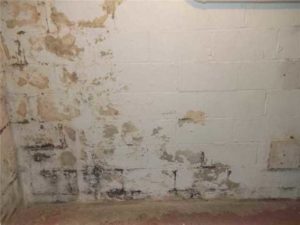Green/White/Yellow/Black Mold on Basement Wall Cinder Blocks
If you have mold on the cinder blocks in your basement, we suggest that you speak with a professional by calling the number on our website. Letting this issue persist can cause damage to your property and health. Here is more information on how to remove mold from cinder block basement walls.

Health Risks of Cement Block Mold
Mold can carry varying health risks depending on the type. For example, black mold on cinder blocks generally causes more health issues than white mold, mainly because it releases more mycotoxins into the atmosphere.
Some health risks associated with mold and mycotoxins include:
- Allergies
- Memory problems
- Fatigue
- Sleep issues
If you have recently experienced any of these issues, particularly after your property experienced water damage, there may be mold growing. If you are not sure, because the mold is not quite visible, we recommend using a mold testing kit, like the one found on our resources page, to check your home.
Can Mold Grow on Concrete Block?
Unfortunately, mold is quite common in buildings, and therefore the answer to this is yes, especially in wet and humid climates. Other factors that contribute to mold growth are temperatures of around 70-90 degrees Fahrenheit and poor air circulation in the building. If any of these are present in your building, it is a good idea to change that by using equipment like dehumidifiers and by opening the doors and windows to promote better circulation.
Causes of Cinder Block Mold
Mold requires a moisture and food source in order for it to grow, and unfortunately our buildings have many of these.
Potential moisture sources include:
- Busted pipes
- Fire sprinklers going off
- Faulty plumbing or HVAC components
- Heavy rains and storms
- Leaks
Potential food sources for mold include:
- Wood
- Carpet
- Drywall
- Cinder blocks
All this being said, one of the best ways to prevent mold from find its way into your property is to make sure that you keep your home or commercial property well maintained.
Cinder Block Mold Removal Process
The remediation process is relatively simple, but should be done by a professional to assure that it is done correctly. Here is how it generally works:
Step 1: Analyze the Mold Issue and Come up with a Plan
In some cases the cinder block mold removal process may, at least partially, be covered by your insurance company, so it is a good idea to document the process well. This is one of the primary reasons the restoration company you hire should inspect the building, and take note of the current damages and causes before the process begins.
Step 2: Move Your Personal Belongings
This process involves moving any personal belongs that may be in the way of cleaning the mold. This will make it easier for the professional you hire to reach the mold and make it less likely that mold spores spread to your contents.
Step 3: Assess the Moisture Issue
As mentioned above, moisture is one of the main factors that causes mold requires to grow. In this case, your mold abatement contractor should look for where the moisture may be coming from and repair it. This process will often involve using a moisture meter like the one found here to complete.
Step 4: Isolate the Contaminated Area
Isolating the contaminated area can help prevent mold spores from spreading during the fungus remediation process. For a small mold mitigation process, your contractor should only need to close all of the doors and windows that may be connected to the contaminated room. If the issue requires level two remediation, your contractor will also cover any openings with polyethylene sheeting.
Step 5: Remove the Contaminated Area
If there is a relatively substantial amount of mold growth, demolishing the mold damaged areas is often necessary. Your mold professional should have the knowhow and equipment to perform this process.
Step 6: Dispose of the Demolished Building Materials
Proper disposal of the mold damaged materials is key to reducing your chances of mold growing in the future. For this reason, your contractor should double-bag the building materials in 6 millimeter thick plastic bags. Your restoration contractor should also wipe down the outside of the bags to make sure that they are sanitized.
Step 7: Clean and Sanitize
Learning how to clean mold off cinder block walls is a relatively simple process. Cleaning helps to remove any remaining mold that may still be present after the demolition process. A professional can use a wire brush to clean the mold contaminated surfaces, and then wipe them down with disposable wipes. These wipes should then be disposed of in the same way as the demolished building materials.
Step 8: Water Damage Restoration
Once the moisture source has been fixed, it is time to move onto the drying process. Your restoration professional will strategically place specialized fans and dehumidifiers near the affected area to help the drying process. They will then monitor this equipment on a regular basis and make adjustments until the property has reached a safe level of moisture.
Step 9: Replace the Building Materials
During this process, all of the structural materials that were removed should either be put back or reconstructed to make the building look like it did before. If the restoration contractor does not offer reconstruction services, they may recommend a specialist to handle it.
Step 10: Cleaning and Putting Back Your Personal Belongings
Now that the structure is back to normal again, your contractor will need to clean your personal belongings and put them back in place. Depending on how damaged your personal belongings are, and how much you have, this can take some time. In the case that some or all of your personal belongings cannot be salvaged, your contractor can try to submit them for reimbursement with your insurance company. This may not always work, but it is generally a good idea to document the process regardless.
Prevent Mold from Coming Back
Unfortunately, it is quite common for mold to grow back, so it is important that you take the necessary precautions to lower the chances. You can do this by implementing some of these methods:
- Maintaining HVAC and plumbing components.
- Regularly check for and repair any leaks or other water damage issues. You can do this using a moisture meter like the one found on our resources page.
- Waterproofing some or all of the materials in your property.
- Clean and fix your roof and gutters when needed.
- Use a HEPA filter link the one mentioned on our resources page to reduce the amount of mold spores in the air.
- Keep your properly ventilated by opening your doors and windows and using fans.
Call Now!
If you see mold on the cinder blocks in your basement walls of your home or commercial building, call today for a free quote!
